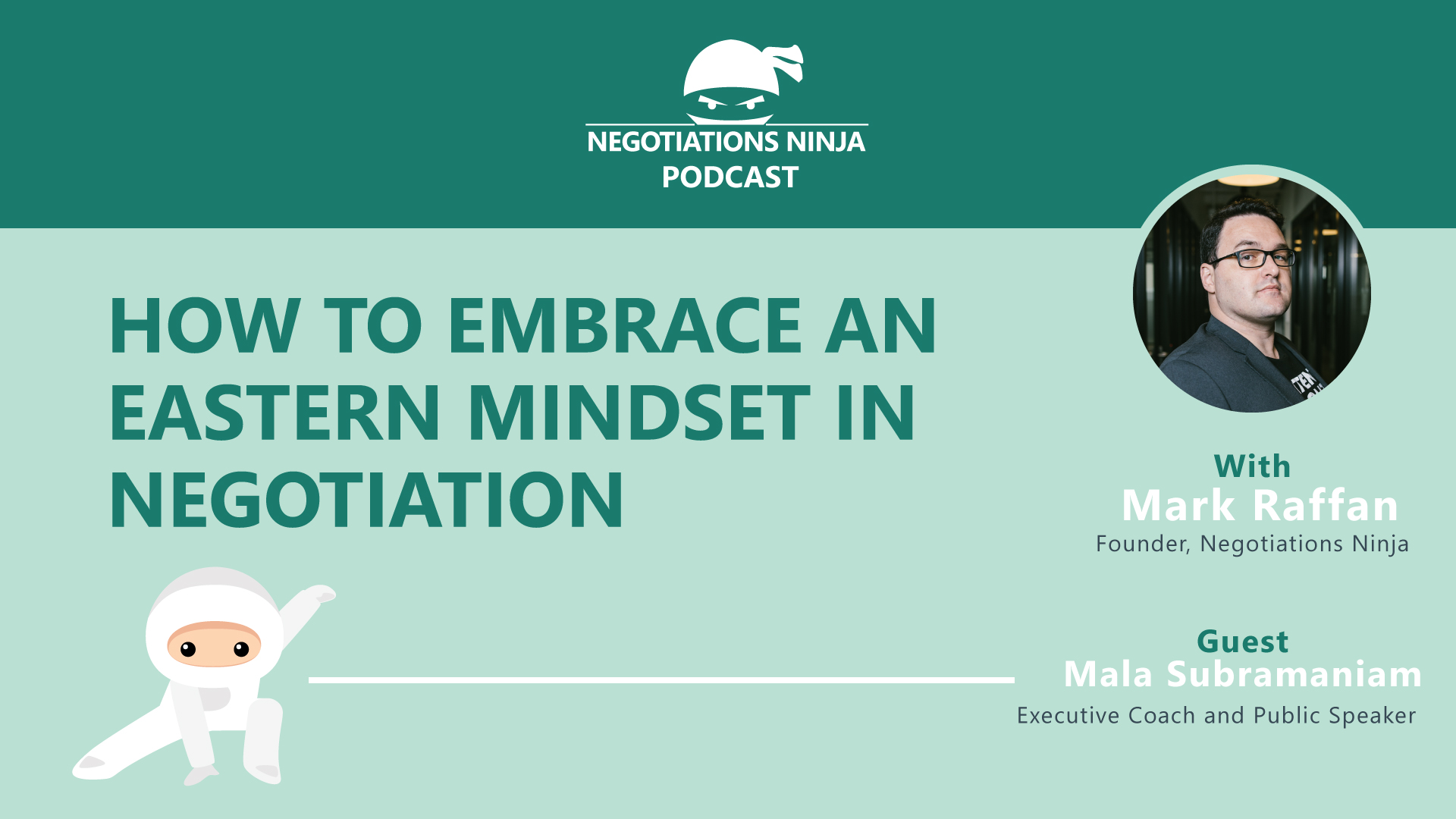How do you apply an Eastern mindset in negotiation? What are some of the core principles that Eastern cultures base their negotiations on? How can an American embrace some of these principles to create long-term and successful relationships? Mala Subramaniam joins me in this episode of Negotiations Ninja to educate us on Indian and East-Asian negotiation and how it differs from American and/or European styles. She also shares seven successful behaviors you can embrace from an Eastern mindset that will have a long-term impact on your negotiations.
Mala Subramaniam is an executive coach, corporate speaker, and cross-cultural trainer who has spent over 20 years blending Eastern and western negotiation styles. She is also the author of the book: Beyond Wins: Eastern Mindset for Success in Daily Business Negotiations. Don’t miss her expertise and insight in this informative episode.
Outline of This Episode
- [1:47] Mala Subramaniam’s background in negotiation
- [4:15] The difference between an Eastern mindset and Western mindset
- [6:18] The differences in communicating the word ‘no’
- [8:34] Seven behaviors that set you up for success
- [16:52] Meditation and mindfulness as part of negotiation training
- [19:52] The concept of Chakra in negotiation
- [22:04] Why the intention doesn’t align with an Eastern Mindset
- [25:21] One negotiation style does NOT fit all
- [27:33] How to connect with Mala Subramaniam online
The differences between Eastern and Western approaches
Mala points out that the North American focus is on signing contracts and getting the deal. Once the contract is signed, the negotiation ends and there tends to be little ongoing communication beyond what’s necessary. The Eastern mindset is that a negotiation is relationship-driven. Mala emphasizes that you have to get to know the people you’re working with: “The contract is not the end of it—it’s the beginning of a relationship. You have to build a relationship.” But American negotiation is structured, time-driven, process-driven, and can be very formal.
In the United States, we are very direct with “no” whereas in Asian countries you won’t hear a direct “no.” Instead, there will be an indirect “no” that you have to learn how to hear. They will be nice and polite and give indirect hints. Mala shares an apt example: If you invite someone in India to a meeting, they’ll say “Yes, yes” and will ask what the date and time is. Then they’ll say “Did you see the invitation I sent to you for my son’s wedding?” That is how you know they’re busy that day and cannot come. In India, the “R” in RSVP stands for “Rude.” It’s rude to expect people to say they can or cannot come.
Cultural differences in negotiation
Mala notes that North Americans get very specific in a negotiation. We dive in with timelines, deadlines, pricing, and immediately go into the facts and specifics. In India, the Eastern mindset is to take a top-down approach. You have to look at the broader approach and the long-term relationship first: What is the company going through? What are the problems? How can this project solve that problem? You have to position the project and who you’re going to be working with. So the “who” matters a lot in Asian countries and the “what” matters in the United States. Mala shares seven behaviors that set you up for success in negotiation—listen as she takes a deep-dive into a concept she outlines in her book!
The intention of “winning” doesn’t align with an Eastern mindset
In negotiation with an Eastern counterpart, you should not go in with the sole intention of winning. A “win” is event-based with a beginning and an end, and it is short-term in duration. You don’t go in with the intent to make the most money or argue over how much they’d pay. A win-win is not quantifiable and there is no shared understanding or goal.
Instead, Mala notes that the Eastern mindset is that your intention should be to go in to build a relationship. Mala started working with a company where she intended to set up an executive coaching program. It came into fruition four years later than she dreamt of it, but it happened. She didn’t go in with a “win at all costs” attitude. She went in with a goal that would benefit the business she was working with. Mala ends her thought by saying “Success is like a journey. It is long-term, and at the same time it produces results.”
One negotiation style does not fit all
Mala advises that you shouldn’t go read a book or attend a training session and take all of the tools you’ve learned and start applying them. If it doesn’t fit you and your personality—and isn’t who you are—it won’t work for you. It may not work for the client. You have to be sensitive to your audience and cannot embrace “one style fits all” in negotiation. The circumstances dictate whether you will change, shift, or pivot your style and tactics. There is such a wide spectrum of styles and abilities. There’s a huge collection of books and resources available—and all of them help. If you get stuck on one methodology or one process, it is crippling to the success of your negotiation.
Resources & People Mentioned
- BOOK: Never Split the Difference
- BOOK: Getting to Yes
Connect with Mala Subramaniam
- BOOK: Beyond Wins
- Connect on LinkedIn
- Follow on Twitter
Connect With Mark
- Follow Negotiations Ninja on Twitter: @NegotiationPod
- Connect with Mark on LinkedIn
- Follow Negotiations Ninja on LinkedIn
- Connect on Instagram: @NegotiationPod




